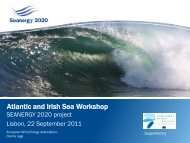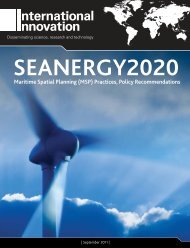Comparative analysis of Maritime Spatial Planning ... - Seanergy 2020
Comparative analysis of Maritime Spatial Planning ... - Seanergy 2020
Comparative analysis of Maritime Spatial Planning ... - Seanergy 2020
Create successful ePaper yourself
Turn your PDF publications into a flip-book with our unique Google optimized e-Paper software.
detail by identifying priority areas and reserved areas and decision rules where different uses overlap. Forinstance where a priority designation for pipelines overlaps with priority areas for wind energy, pipelinesare given priority. The embellishment <strong>of</strong> zoning with decision rules is essential for deciding what spatial useshould take precedence in the case <strong>of</strong> a conflict.Nevertheless there is discussion on the extent to which zoning is always necessary and whether it is alsopossible to effectively manage maritime space using a criteria-based approach, as another approach thathas been proved to work efficiently. For instance in the UK rather than having planning inclusion orexclusion zones the UK Government has established a series <strong>of</strong> criteria that are used when approving orrejecting a planning proposal. The criteria include whether the proposed development conflicts with aseries <strong>of</strong> criteria including consideration <strong>of</strong> impact on various constraints, whether „hard‟ or „s<strong>of</strong>t‟. A hardconstraint, for example, would be the existence <strong>of</strong> oil platforms or major shipping routes. The constraintstend to be more numerous nearer the coast. Based on these criteria the Crown Estate, owners <strong>of</strong> theseabed, have earmarked zones that are suitable for <strong>of</strong>fshore wind farm development. These are notplanning zones, although they would have taken likely planning consent into consideration, but leasingzones. An <strong>of</strong>fshore wind-farm developer therefore requires a lease from the Crown Estate and then to gothrough the procedure for planning consent where the application will be judged against the criteria.What is clear that even where a detailed zoning exercise has been undertaken activities should not alwaysbe excluded from taking place outside <strong>of</strong> „priority zones‟ and there should be the opportunity to consideroutliers on a case-by-case basis. The initial German zoning exercise was criticised by <strong>of</strong>fshore winddevelopers as it effectively limited the potential areas for development and did not take into account futuretechnological advances or changes in priorities, and this was changed in the final plan. In contrast, the UKsystem does not result in any formal „exclusion‟ zones for wind farms. Although the Government„recommended‟ that the bulk <strong>of</strong> <strong>of</strong>fshore wind farms be outside the 12 nautical mile limit, it also said that<strong>of</strong>fshore wind farms have not been excluded from this range. Projects are therefore considered on a caseby-casebasis. For example some recent <strong>of</strong>fshore wind farms (Round 3) are being planned within the limitalthough the large majority <strong>of</strong> the planned capacity will be outside this near shore area.For some countries, zoning and related decision rules needs to be legally binding to be effectivelytranslated into practice. While the pilot maritime spatial plans in the Baltic Sea provide essentialexperience, they will not be fully implemented unless they are legally required. In many <strong>of</strong> these countriesstakeholders who have had traditional use <strong>of</strong> the maritime zone (e.g. fishermen, navigation) have beenunwilling to negotiate as part <strong>of</strong> a voluntary exercise given they benefit from the status-quo.As with any plan, a zoning exercise also needs to be regularly reviewed and updated to take into accountdynamic changes in the use <strong>of</strong> the sea and environmental conditions.Deliverable 2.337 | P a g e






